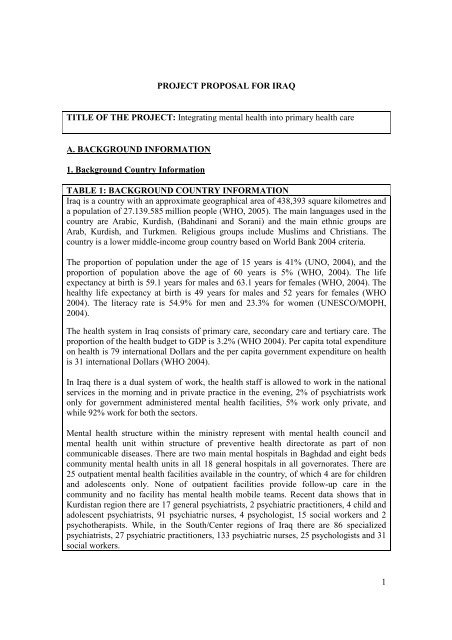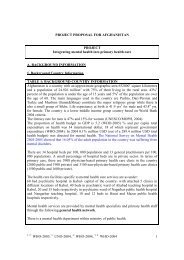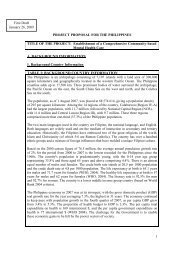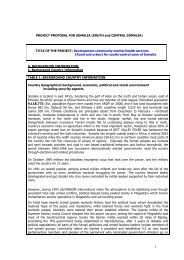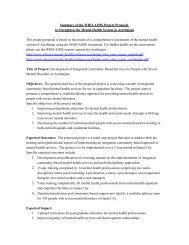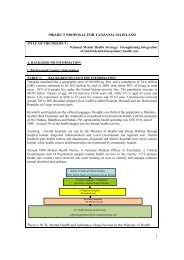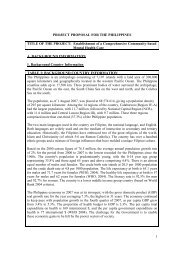PROJECT PROPOSAL IRAQ - Cittadinanza
PROJECT PROPOSAL IRAQ - Cittadinanza
PROJECT PROPOSAL IRAQ - Cittadinanza
You also want an ePaper? Increase the reach of your titles
YUMPU automatically turns print PDFs into web optimized ePapers that Google loves.
<strong>PROJECT</strong> <strong>PROPOSAL</strong> FOR <strong>IRAQ</strong>TITLE OF THE <strong>PROJECT</strong>: Integrating mental health into primary health careA. BACKGROUND INFORMATION1. Background Country InformationTABLE 1: BACKGROUND COUNTRY INFORMATIONIraq is a country with an approximate geographical area of 438,393 square kilometres anda population of 27.139.585 million people (WHO, 2005). The main languages used in thecountry are Arabic, Kurdish, (Bahdinani and Sorani) and the main ethnic groups areArab, Kurdish, and Turkmen. Religious groups include Muslims and Christians. Thecountry is a lower middle-income group country based on World Bank 2004 criteria.The proportion of population under the age of 15 years is 41% (UNO, 2004), and theproportion of population above the age of 60 years is 5% (WHO, 2004). The lifeexpectancy at birth is 59.1 years for males and 63.1 years for females (WHO, 2004). Thehealthy life expectancy at birth is 49 years for males and 52 years for females (WHO2004). The literacy rate is 54.9% for men and 23.3% for women (UNESCO/MOPH,2004).The health system in Iraq consists of primary care, secondary care and tertiary care. Theproportion of the health budget to GDP is 3.2% (WHO 2004). Per capita total expenditureon health is 79 international Dollars and the per capita government expenditure on healthis 31 international Dollars (WHO 2004).In Iraq there is a dual system of work, the health staff is allowed to work in the nationalservices in the morning and in private practice in the evening, 2% of psychiatrists workonly for government administered mental health facilities, 5% work only private, andwhile 92% work for both the sectors.Mental health structure within the ministry represent with mental health council andmental health unit within structure of preventive health directorate as part of noncommunicable diseases. There are two main mental hospitals in Baghdad and eight bedscommunity mental health units in all 18 general hospitals in all governorates. There are25 outpatient mental health facilities available in the country, of which 4 are for childrenand adolescents only. None of outpatient facilities provide follow-up care in thecommunity and no facility has mental health mobile teams. Recent data shows that inKurdistan region there are 17 general psychiatrists, 2 psychiatric practitioners, 4 child andadolescent psychiatrists, 91 psychiatric nurses, 4 psychologist, 15 social workers and 2psychotherapists. While, in the South/Center regions of Iraq there are 86 specializedpsychiatrists, 27 psychiatric practitioners, 133 psychiatric nurses, 25 psychologists and 31social workers.1
Table 8Step 1Step 2SPECIFICOBJECTIVEIncrease thecapacity of primaryhealth care staff todiagnose and treatmental disordersEstablishment ofcommunity mentalhealth unit asseparate unit inprimary health carecenterACTIONS ACTORS TIME RESULTS INDICATORSTraining of primaryhealth care physicians,nurses and healthworkers on mentalhealth and thedevelopment of atraining module.Three leveltrainings 6 dayseach in threeprovinces- The trained nurse onmental health workwill function asCommunity MentalHealth Worker(CMHW)- The Trained GP atPHC centre supportand supervise theCMHWDepartment of mentalhealth MoH, teachinghospitals, university,professionalorganizations, primaryhealth care doctors,NGOS- Director general ofeach health directorateand mental healthfocal point.- CMHW- General Practitioners2009-2010 A training moduleon mild and severemental disordersdeveloped; 120nurses and 120doctors trained onmental health2009- 2010 90 CMH unitsdeveloped- No. of doctors, nurses &trained- No. of sub districtscovered, number ofpatients treated in primarycare centres,- Psychotropic drugsconsumed- Referrals betweenprimary care and specialistservices- No. of functioning CMHunits- Number of patientstreated or referred duringyear- Number of communityvolunteers trained duringone year- Number of familycounselling sessionsprovided during one year- Liaison body established- No. of meetings held- Reports to nationalmental health council- No. of problems tackledduring one year- No. of participatoryeducational activitiesperformed during one yearStep 3 To ensure themonitoring processand developmechanisms to dealwith potentialproblems ofintegrationEstablishing a liaisonbody between mentalhealth focal point ateach noncommunicable diseaseunit at eachdepartment andcommunity mentalhealth unitsDirector general ofeach health directorateand mental healthfocal point.2009- 2010 3 Liaison bodyestablished & 9interactions meetingheldStep 4 Mid-term evaluation Set up teams to Directorate of health 2010 Mid-term evaluation Mid-term evaluation teams4
MEDICINES Expected increase in consumption of 500.000US$psychotropic drugsOTHERS (specify) Experts consultations 100.000US$Total1.300.000US$TABLE 13:POSSIBLE SOURCES OF FUNDING (these sources are presumed andnot necessarily already found now).FUNDERGovernment - Department of Health500.000 US$NGOs300.000US$WHO500.000US$Others (specify)Total1.300.000US$7


